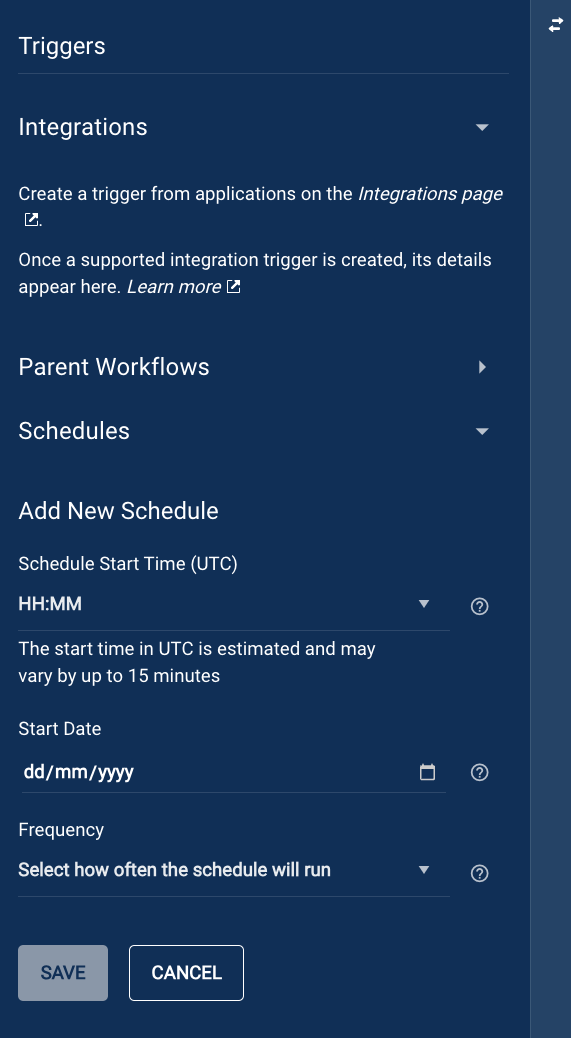Applies to
Bridge: Schedule workflow runs
Schedule workflows to run at fixed times, or to be dynamically triggered by another workflow.
You can use fixed schedules to automate daily reminders or weekly task creation. You can also use dynamic schedules when the start time depends on another event, such as a change in project status or when information is added.
Create a fixed schedule within the trigger
- Navigate to the workflow and select the trigger module at the top.
- Expand the Schedules section and select Add new schedule.
- Choose a start time (UTC) and a future start date.
- Choose a frequency to set how often the schedule triggers the workflow. This can be Once, Hourly, Daily, Weekly, Monthly, Annually, or Custom cadence.

Create a dynamic schedule with a utility module
In the Designer, go to Utilities > Scheduling.
- Add the Create Workflow Schedule utility module to your workflow.

- Select the workflow name for which you want to create a schedule.
You can select the same workflow the module is in, but only when the workflow ends with a junction that decides whether to create a schedule and the frequency is Once (e.g., determining if the workflow should run once more in a week). If there isn’t a junction, once the workflow triggers the first time, it creates a loop generating an infinite number of schedules. If this happens, delete the module from the workflow and save it. This should stop the loop unless a frequency other than Once were used.
- If the other workflow needs to reference information, such as a sheet ID or row ID, you can add a state for each value in the workflow to be scheduled. In the module, expand the State Values section and enter the name of each state in the Key field, as well as the reference or exact value in the Value field. When the other workflow is triggered by the schedule modules, it can reference those states to obtain the values.
- Select how to set the start time:
- When The Workflow Runs: the schedule’s start date and time are the same as the module’s execution time.
- On A Specified Date: The scheduled start date and time reference a specific date. The date can be in ISO format or a Unix timestamp.
- Choose a frequency to set how often the schedule triggers the workflow. This can be Once, Hourly, Daily, Weekly, Monthly, Annually, or Custom.
The following data is available in the Run Log once the module has executed:
- Created At The time the schedule was created.
- Frequency: The frequency of the new schedule, corresponding to the value set in the frequency settings of the module.
- ID: The ID of the schedule.
- Start At: the created schedule’s start time as a Unix timestamp. If the start time was referenced, the time presented in the Run Log will be in the format of the referenced time, i.e., ISO or Unix.
- Workflow ID: the unique ID of the scheduled workflow.
Keep in mind the following
- When you select Monthly, a checkbox option to run automatically on the last day of the month appears. If you select a date that doesn’t exist every month (such as the 29th, 30th, and 31st) and the box is unchecked, the workflow triggers only in the months where the date exists. However, if you check the box, the workflow triggers on the last day of each month. If the start date is any other date of the month, it doesn’t matter if you checked the box or not.
- You can select a custom frequency to access more options, such as how often the workflow should run by setting a number and unit (e.g., every 7 hours). Note that the start time for any schedule isn’t guaranteed, so the workflow could take up to 15 minutes to run.
If the schedules being created have a recurring frequency, deciding how to delete them before they start being created is good practice. This could be as a result of the scheduled workflow or by updating the source that caused it to be created with the schedule ID so that it can be referenced for deletion later.
Delete a schedule dynamically
Use the Delete Schedule module to delete schedules dynamically and stop triggering a workflow. This workflow could be the one that was originally scheduled or a completely separate one.
The Delete Schedule module has one field where the schedule’s ID is referenced. The workflow still runs successfully if the referenced schedule doesn't exist.
The following data is available in the Run Log once the Delete Schedule module has executed:
- Status: If a schedule existed and was successfully deleted, the status is Schedule deleted. If a schedule didn’t exist, the status is Schedule not found.
Delete or edit a schedule manually
All workflow schedules appear in the workflow's trigger panel for which the schedule is for. To delete a schedule:
- Navigate to the workflow.
- Select on the cog next to it.
- Select Edit or Delete.
If a schedule doesn’t trigger the workflow to run again in the future, the schedule won’t be visible in the panel and can’t be deleted.
You can’t deactivate schedules. To stop a scheduled workflow from executing, you must delete it.